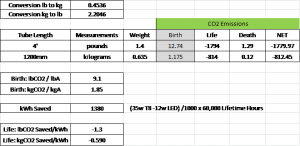- 4 reads

LED Tube Impact Analysis: Grey Energy and NET CO2 Savings
Grey energy is the embodied energy that is the total energy used to make something. As an example, when someone drinks a glass of milk, the grey energy includes the transportation of the food to the cow and the transportation of the milk to the creamery. EXAMPLE of Transportation Reduction: By moving its manufacturing from China to Pennsylvania in 2010, Independence LED (www.IndependenceLED.com) has been able to reduce major aspects of its grey energy. The aluminum extrusion production is now within the same state as the Company’s diode application and tube assembly. The NET Carbon Dioxide (CO2) Savings naturally takes into account the grey energy, because the NET is the CO2 saved through the energy efficiency of the LED tube minus the CO2 emissions required to initially produce the LED tube.
Birth: The environmental impact calculation begins with the production of each LED tube. According to Charlie Szoradi, the Chairman of Independence LED, "For Independence LED, the vast majority of the mass of each of our LED tubes is in the aluminum heat sink." According to Calsmelt, the licensor of low cost, sustainable, aluminum smelting technology, there are 1.5 to 2.2 kilograms (kg) of CO2 emitted for each kg of aluminum produced. The conversion to pounds is as follows: A kg is more than twice as heavy as a pound (lb). So, 1 kg = 2.20462 lbs, making 1 lb = 0.453592 kg. The Calsmelt data converts to 3.306 to 4.850 lbs of CO2 emitted for each kg of aluminum and 7.29 to 10.69 lbs for each lb of aluminum. The average is 8.99 lbs of CO2 emissions for each lb of aluminum production. As a cross check, according to, CO2list.org, aluminum emits 9.2 lbs of CO2 for each lb of aluminum production. The data matches up and averages to 9.1lbsCO2/lbA and 1.85kgCO2/kgA. The most common Independence LED tube length is 4' (1200mm), and the aluminum weighs 1.4 lbs (.635 kg). At birth each of these tubes generates 12.74 lbs (1.175kg) of CO2
Life: The life of the Independence LED tube yields positive CO2 savings that far exceed the emissions from its birth. The grey energy is less than 1% of the total CO2 savings. By comparison, energy efficient vehicles such as hybrid cars may have a much larger ratio and larger initial burden on the environment given the complexity of production and the end of life battery disposal considerations. Plus, at office hours levels, the LED tube will run for over 20 years, so it has the added advantage of longer life than an average vehicle. Other equipment such as energy saving furnaces and air conditioning systems are closer to the automotive model in that they have a larger CO2 burden than LED tubes relative to the NET CO2 savings. According to Mr. Szoradi, "The most common Independence LED tube length is 4' (1200mm). It uses 12 watts to replace the common 4' (1200mm) T8 fluorescent that uses 32 watts and carries a ballast factor for total power consumption of 35 watts." The energy savings on these LED tube lights is over 65% which is higher than the savings generated by cars or climate control systems relative to their peers. The 60,000 hour life of the LED tube generates the total lifetime energy savings is 1,380 kWh over the fluorescent tubes. According to the U.S. Department of Energy (DOE) there are 1.3 lbs of CO2 Savings for every kWh saved. See DOE on CO2. This converts to .590 kg of CO2 saved for every kWh saved. Each LED tube generates lifetime CO2 savings of 1,794 lbs or 814 kg.
Death: Independence LED has designed its modular system with the deep fin aluminum heat sink for reuse rather than recycling or disposal. The Cradle to Cradle approach yields a technology rebirth. For the purposes of this NET CO2 calculation, recycling is considered. According to CO2List.org, recycling typically saves 90% of the CO2 released by making aluminum and plastic; while only 40% for glass, steel, and paper. Given that 100% of the LED tube aluminum is re-useable or recyclable and that recycling for aluminum saves 90% of the CO2, there is a 1.29 lb (.12 kg) emission of CO2 for each tube at the end of life.
NET CO2 Savings: The NET CO2 savings over the life of the Independence LED 4' (1200mm) 12 watt LED tube is 1780 lbs or 812 kg. See Data Table + More Info

